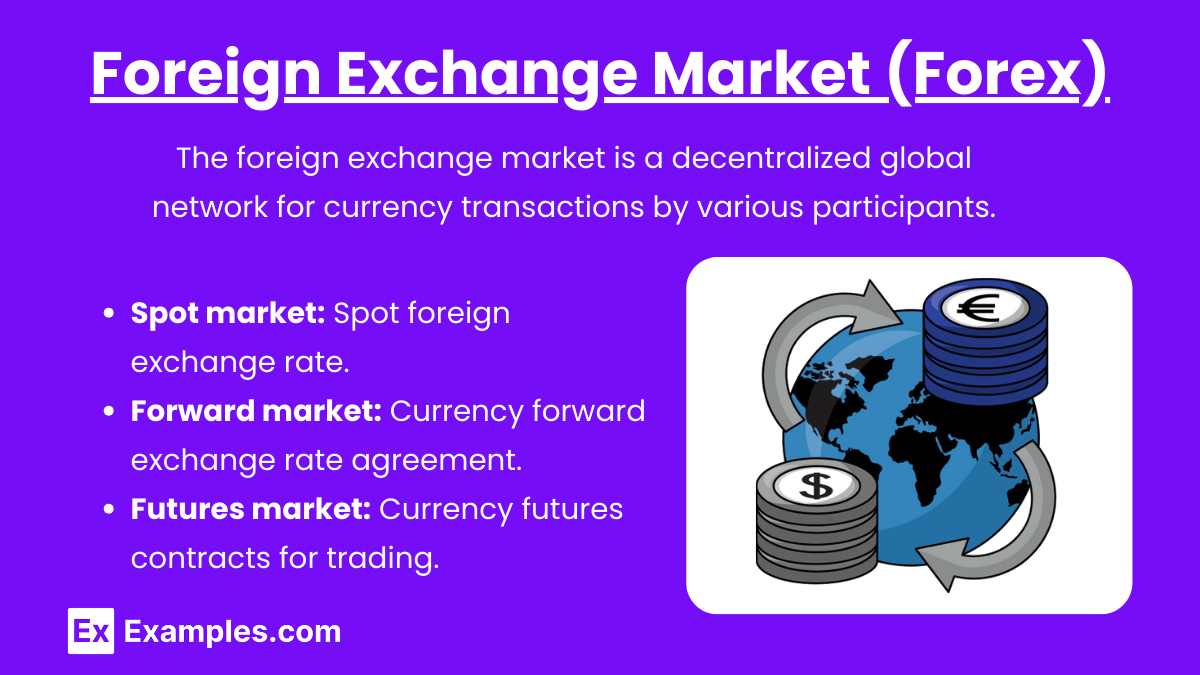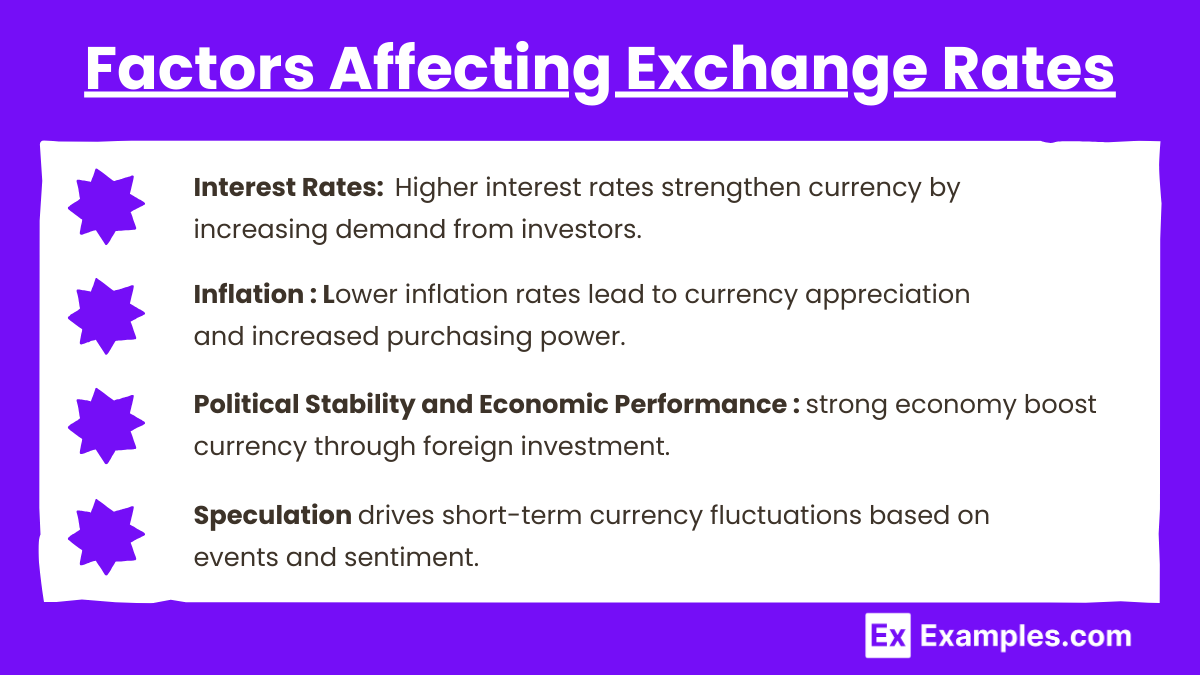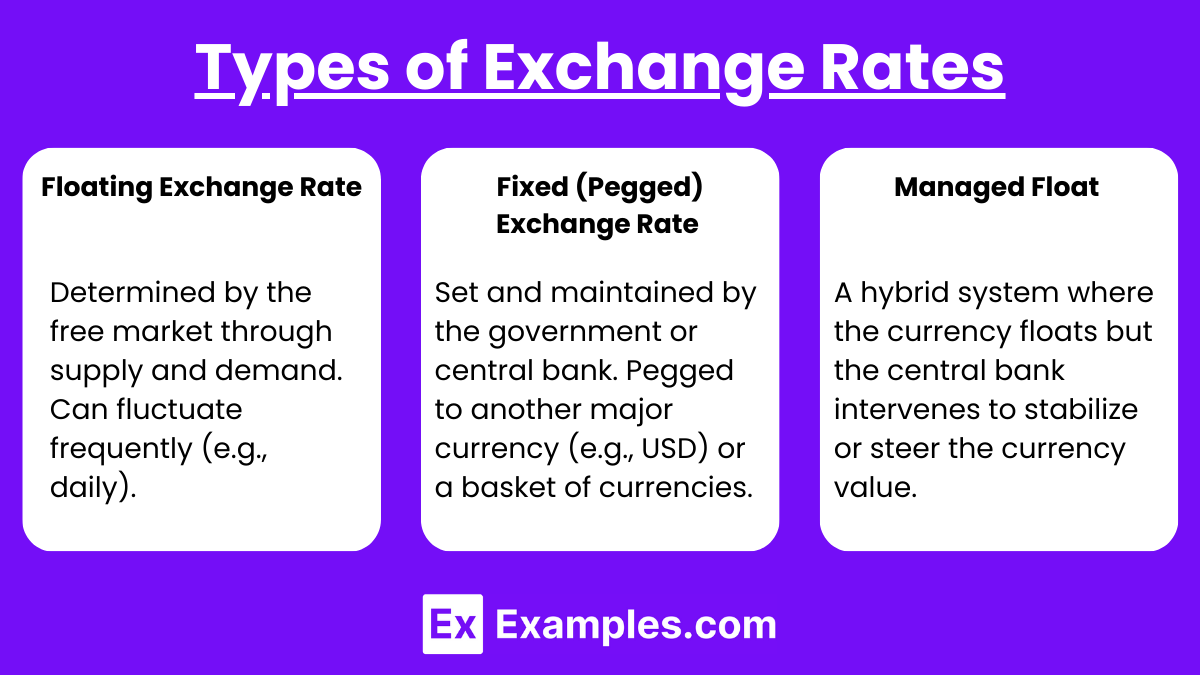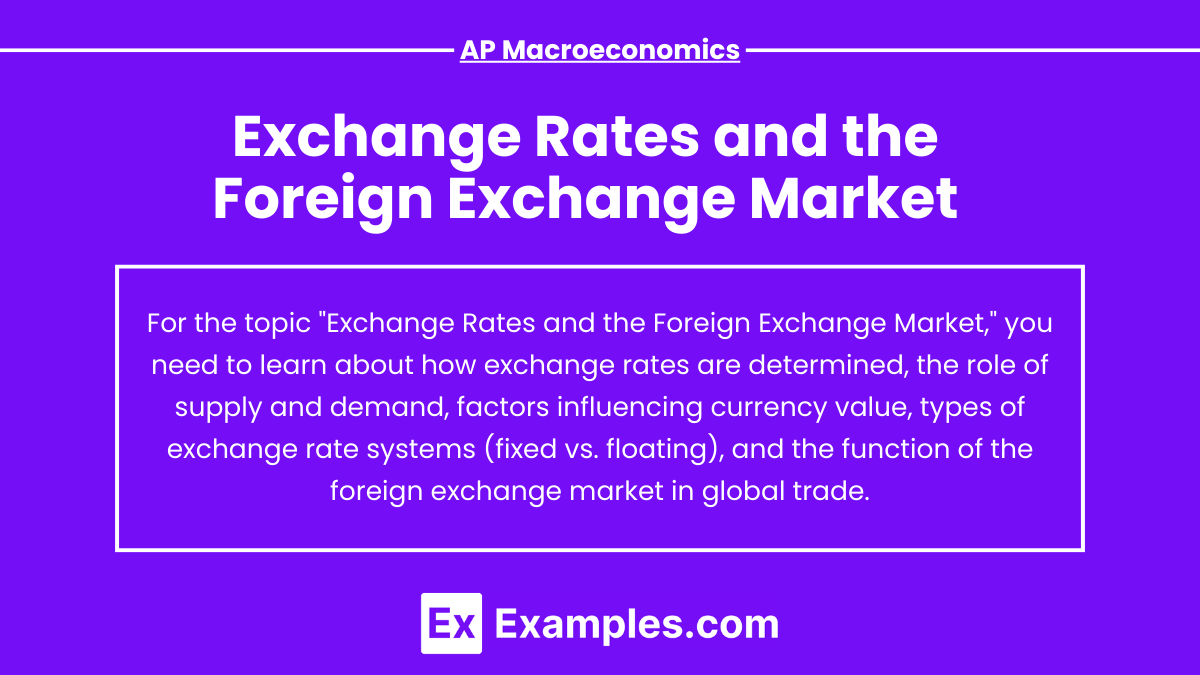Exchange rates and the foreign exchange market are fundamental concepts in AP Macroeconomics, essential for understanding how countries engage in international trade and investment. Exchange rates determine the value of one currency relative to another, influencing import and export prices, capital flows, and economic stability. The foreign exchange market is the global platform where these currencies are traded, driven by factors such as interest rates, inflation, and political events. Mastering these topics is crucial for analyzing a nation’s economic interactions and policy decisions in AP Macroeconomics.
Learning Objectives
In studying “Exchange Rates and the Foreign Exchange Market” for AP Macroeconomics, you should aim to understand the fundamental definitions and types of exchange rates, including floating and fixed systems. Grasp how supply and demand determine currency values and the key factors that influence these rates, such as interest rates, inflation, and economic performance. Analyze the effects of exchange rate fluctuations on a country’s trade balance, inflation, and overall economic health. Additionally, learn about the role of the foreign exchange market, policy tools for managing exchange rates, and relevant economic theories like Purchasing Power Parity and Interest Rate Parity. Mastery of these objectives will equip you to tackle related exam questions confidently.
Introduction of Exchange Rates
An exchange rate expresses the value of one country’s currency in relation to another’s. For instance, if $1 USD equals €0.85 EUR, this is the exchange rate between the U.S. dollar and the euro. Exchange rates can either be floating (determined by market forces) or fixed (set by a country’s government or central bank). Floating exchange rates fluctuate according to supply and demand in the market, while fixed rates are pegged to another currency or a basket of currencies, and are usually adjusted periodically.
Foreign Exchange Market (Forex)

The foreign exchange market is decentralized and consists of a global network of banks, corporations, governments, and individuals engaging in currency transactions. Forex operates through:
- Spot market: The current exchange rate for immediate delivery of currencies.
- Forward market: Agreements to exchange currencies at a future date at a predetermined rate.
- Futures market: Contracts to buy or sell currencies at a future date based on standard quantities.
Forex trades are driven by a combination of factors such as interest rate differentials, inflation expectations, political stability, and economic performance.
Factors Affecting Exchange Rates

Several key factors influence the supply and demand for currencies:
- Interest Rates: Higher interest rates offer investors better returns on assets denominated in that currency, increasing demand and strengthening the currency.
- Inflation: Countries with lower inflation rates tend to see appreciation in their currency’s value as purchasing power increases.
- Political Stability and Economic Performance: Nations with stable governments and robust economies generally attract foreign investment, leading to currency appreciation.
- Speculation: Investors and traders anticipate future movements of currencies based on geopolitical events, market sentiment, or economic data, influencing short-term fluctuations.
Exchange Rate Systems

Exchange Rate Systems refer to the various approaches a country uses to manage its currency relative to other global currencies. These systems directly impact international trade, investment, and monetary policy. The three main exchange rate systems are:
Types of Exchange Rates

- Floating Exchange Rate : Determined by the free market through supply and demand. Can fluctuate frequently (e.g., daily).
- Fixed (Pegged) Exchange Rate : Set and maintained by the government or central bank. Pegged to another major currency (e.g., USD) or a basket of currencies.
- Managed Float : A hybrid system where the currency floats but the central bank intervenes to stabilize or steer the currency value.
Implications of Exchange Rate Fluctuations
- Impact on Trade: A stronger domestic currency makes exports more expensive and imports cheaper, potentially reducing export competitiveness but benefiting consumers with cheaper imported goods. A weaker currency has the opposite effect, boosting exports but increasing the cost of imports.
- Balance of Payments: Exchange rate movements affect a country’s current account and capital account, which are components of its balance of payments. A favorable exchange rate can help a nation reduce trade deficits.
- Inflation: A depreciating currency can lead to inflationary pressures as the cost of imported goods rises. In contrast, currency appreciation can help control inflation by reducing import prices.
Examples
Example 1. The U.S. Dollar Strengthening Due to Rising Interest Rates
Scenario: The Federal Reserve (the U.S. central bank) decides to increase interest rates to combat rising inflation.
Explanation: Higher interest rates offer better returns on investments denominated in U.S. dollars, attracting foreign investors seeking higher yields. This increased demand for the dollar in the foreign exchange market leads to an appreciation of the U.S. dollar relative to other currencies. As the dollar strengthens, American exports become more expensive for foreign buyers, potentially reducing export volumes. Conversely, imports become cheaper for U.S. consumers, which might increase import volumes. This scenario demonstrates how monetary policy and interest rate changes directly influence exchange rates through capital flows.
Example 2. The Euro Depreciates Following Political Uncertainty in the Eurozone
Scenario: A major political crisis emerges in a Eurozone country, causing uncertainty about the region’s economic stability.
Explanation: Political instability can erode investor confidence in the affected country’s economy and, by extension, the Eurozone as a whole. Investors may withdraw their investments, leading to a decrease in demand for the euro as they convert their holdings into more stable currencies like the U.S. dollar or the Japanese yen. The reduced demand causes the euro to depreciate in the foreign exchange market. A weaker euro makes European exports cheaper and more competitive internationally, potentially improving the trade balance. However, imports become more expensive for European consumers, which could contribute to higher inflation within the Eurozone.
Example 3. Japan’s Central Bank Intervenes to Prevent Yen Appreciation
Scenario: The Japanese yen begins to appreciate rapidly against the U.S. dollar, threatening Japan’s export-driven economy.
Explanation: To prevent the yen from becoming too strong, which would make Japanese exports more expensive and less competitive globally, the Bank of Japan (Japan’s central bank) intervenes in the foreign exchange market. It does so by selling yen and buying foreign currencies, increasing the supply of yen in the market. This intervention helps to stabilize or even depreciate the yen’s value. Such actions exemplify how central bank interventions can influence exchange rates to support national economic interests, particularly in maintaining a competitive export sector.
Example 4. The British Pound Weakens Due to High Inflation Rates
Scenario: The United Kingdom experiences a significant increase in inflation, eroding the purchasing power of the British pound.
Explanation: High inflation in the UK reduces the real value of the pound, making British goods and services more expensive both domestically and internationally. As a result, foreign demand for the pound declines because investors and consumers seek currencies with stronger purchasing power. Simultaneously, British consumers may increase their demand for foreign currencies to purchase cheaper imported goods, increasing the supply of pounds in the foreign exchange market. This combination of decreased demand and increased supply leads to a depreciation of the British pound. This example highlights the relationship between inflation rates and exchange rate movements, where higher inflation typically leads to currency depreciation.
Example 5. China Adopts a Managed Float to Control the Renminbi’s Value
Scenario: China opts for a managed float exchange rate regime to balance economic growth and currency stability.
Explanation: Instead of allowing the renminbi (RMB) to float freely or peg it rigidly to another currency, China implements a managed float system. Under this regime, the People’s Bank of China (China’s central bank) allows the RMB to fluctuate within a certain range against a basket of currencies while intervening as necessary to prevent excessive volatility. This approach provides flexibility to respond to market forces while maintaining some control over the currency’s value to support export competitiveness and economic stability. For instance, if the RMB starts to appreciate too quickly, the central bank may sell RMB and buy foreign currencies to stabilize its value. This example demonstrates how different exchange rate regimes can be employed to achieve specific economic objectives.
Multiple Choice Questions
Question 1
If the U.S. dollar appreciates relative to the euro, what is the most likely immediate effect on U.S. exports and imports?
A) U.S. exports become cheaper, and imports become more expensive.
B) U.S. exports become more expensive, and imports become cheaper.
C) Both U.S. exports and imports become more expensive.
D) Both U.S. exports and imports become cheaper.
Answer: B) U.S. exports become more expensive, and imports become cheaper.
Explanation: When the U.S. dollar appreciates relative to the euro, it means that it takes fewer U.S. dollars to purchase euros, or conversely, it takes more euros to purchase U.S. dollars. This makes U.S. goods and services more expensive for foreign buyers, reducing the competitiveness of U.S. exports. On the other hand, the appreciation makes foreign goods cheaper for U.S. consumers, leading to an increase in imports.
Question 2
Which of the following factors is most likely to cause a country’s currency to depreciate in the foreign exchange market?
A) Higher domestic interest rates relative to other countries.
B) A large current account surplus.
C) A high level of inflation.
D) Political stability and strong economic performance.
Answer: C) A high level of inflation.
Explanation: A country experiencing high inflation will typically see its currency depreciate because the purchasing power of its currency declines. As domestic prices rise, foreign buyers are less likely to purchase goods from the high-inflation country, reducing demand for that currency. Additionally, domestic residents may prefer foreign goods, further increasing the supply of the currency on the foreign exchange market. On the other hand, factors like higher interest rates and political stability generally lead to currency appreciation due to increased investor confidence.
Question 3
Under a fixed exchange rate system, how does a central bank typically maintain its currency’s value?
A) By adjusting the interest rates to match market demand for the currency.
B) By allowing the currency to fluctuate freely based on supply and demand.
C) By buying and selling its currency in the foreign exchange market.
D) By reducing inflation to control currency value.
Answer: C) By buying and selling its currency in the foreign exchange market.
Explanation: In a fixed exchange rate system, the central bank actively intervenes in the foreign exchange market to maintain the currency’s value at a predetermined level. It does this by buying or selling its own currency to adjust supply. For example, if the currency is under downward pressure, the central bank might buy its own currency using its reserves of foreign currencies to prop up its value. Conversely, if the currency is too strong, the central bank might sell its currency to increase supply and lower its value.


